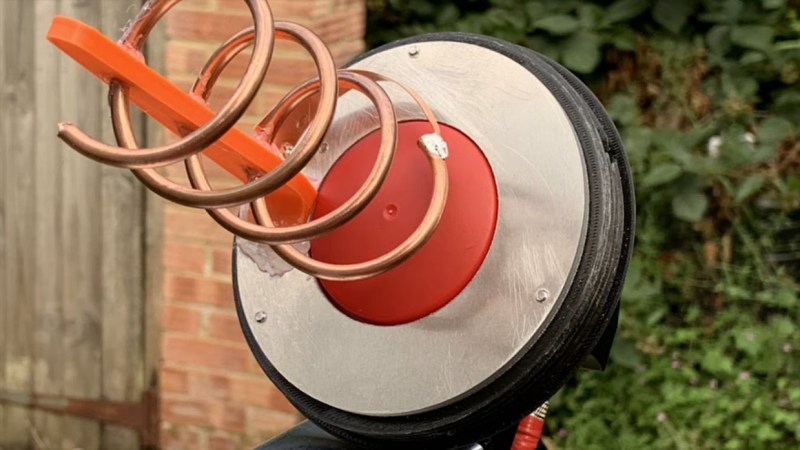Amateur radio operators like to say that working a contact in space can be done with a simple handheld transceiver and a homemade antenna. And while that’s true, it’s true only for low Earth orbit satellites such as the ISS. If you want to reach a satellite in geosynchronous orbit it’ll take a little more effort, and this dual-feed helical “ice cream cone” antenna could really help.
Until recently, the dream of an amateur radio repeater in geosynchronous orbit remained out of reach, but that changed with the launch of the Qatari satellite Es’hail-2 last year. Since then, hams from Brazil to Thailand have been using the repeater, and UK-based [Tech Minds] has been in the thick of the action. The antenna he presents is a hybrid design, needed because of the 2.4-GHz band uplink and 10-GHz downlink on the satellite, also known as QO-100. Both require a largish dish antenna, with the downlink requiring a low-noise block downconverter (LNB) and feed horn. The uplink side of [Tech Minds]’ antenna is a helical design, with three-and-a-half turns of heavy copper wire and a tuning section of copper strapping that attaches directly to an N-type connector. The helix is just the right size for the feed horn of an LNB for the downlink side, nestled in a hole in the helical antenna’s aluminum reflector disc. There are 3D-printed parts to support everything, plus a cone-shaped radome to keep it all safe from the elements.
It looks like a great design, but sadly, North American and East Asian hams can only dream about building one, since QO-100 is below the horizon for us. We’re jealous, but we’re still glad the repeater is up there. Check out this article for more on how Es’hail-2 got the first geosynchronous ham repeater.















If the satellite is geosynchronous, how can it be below the horizon anywhere on earth?
Never mind. I realize why it isn’t visible in the areas you mentioned.
No, I can understand this. You should be able to see it anywhere on the flat earth :-) There is not, by the way, an “other side”.
yes there is (another side), you can stand on top of the turtle and see the underside of the world (looking past the elephants)…
Even Ridicully got to see the underside
Be an elephant!
https://external-preview.redd.it/Uv_2msAO9Zqw1UPCHoxqY2mVsmx3IPbszrbaIG6pIvc.jpg?auto=webp&s=ab9dca129631544b83acef6a95078c97b784a33b
There will be a North American One. It will take years, but we will have one. If you would like to work on it or follow the status, look at http://OpenResearch.institute/ and join the mailing list at http://lists.openresearch.institute/listinfo.cgi/ground-station-openresearch.institute
There was just an online early design review, and you can expect more of the same.
I was just coming here to say I wish there was one of these for the American continent.
Which one?
How is the dB performance vs the POTY?
I have thought that the POTY with it’s Ku plastic rf-optic focal point lens and waveguide tube with S band TX planar antenna sits nicely in the focus of a 0.7-1m offset dish, curious how well the spiral performs in a small dish with a small focal zone?
Maybe the performance is only an advantage when you go to a big old C band dish 2m or larger?
In theory a western hemisphere phase-4 amsat could be done with almost any TV satellite though I imagine the owners of the Eshael bird must be hams because I am guessing that most MBA trained operators and maybe insurers will not risk QOS for other users to allow (licensed) randos to play with a slot of the transponder even if they are getting paid for said privelage. It would be nice if we got secondary user non-interference on the actual Ku band so we can buy a slice of transponder like TV stations do, these birds are all just dumb bent pipes with amazing LNAs.
I imagine for most TV sats getting 3cm is within the tuning ability just down from the satellite Ku band and 2,4ghz/S-band/13cm up.
Re:POTY Ku lens and wavguide I would love to know what lens shape is getting good performance, I see mostly the flat top and double cone. I have a 20mm acrylic rod coming and would like to see some feedback before I start lathing out RF lenses, some people are 3D printing lenses but I dont think I want porous plastic out in the weather. I plan to use a hackrf ,bandpass, and a 2.4ghz amp for the S band up and a Ku LNB – bias-t – RTL-SDR for RX.
A link to the POTY Ku/S dual band worth it’s own HAD article.
https://uhf-satcom.com/blog/patch_antenna
PDF of above:
http://www.hybridpretender.nl/patch.pdf
I have parts coming but have not used this design.
I was listening to OSCAR 100 via Web SDR the other day. Video here:
https://soldersmoke.blogspot.com/2020/08/oscar-100-geosynchronous-satellite-video.html
Just contact Elon Musk and request he send one up on a test flight of the Falcon 9.